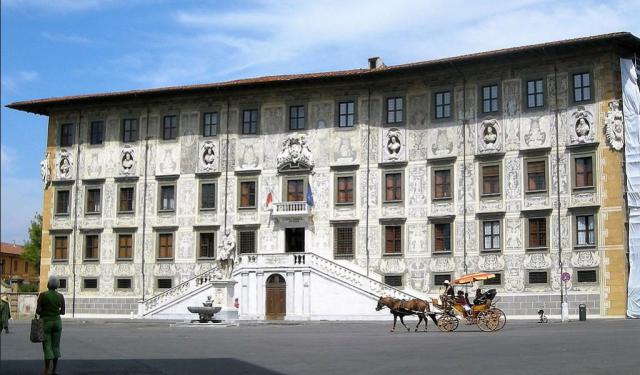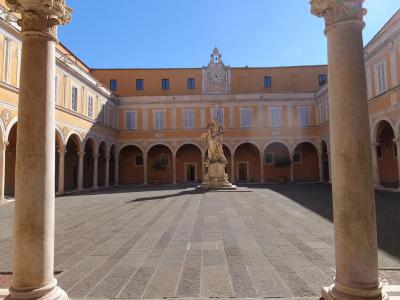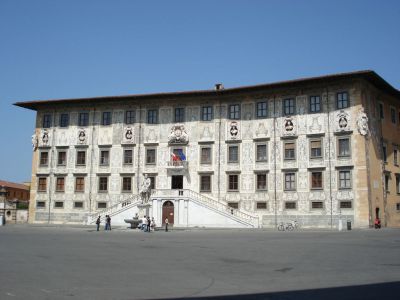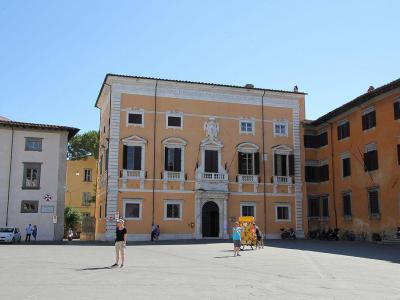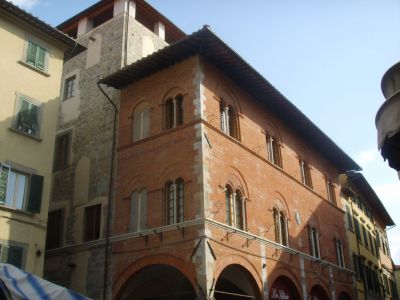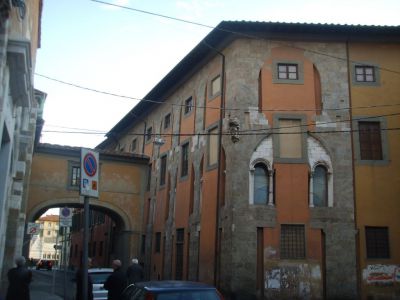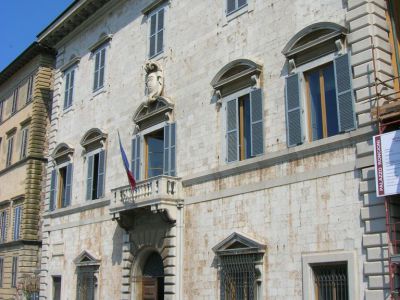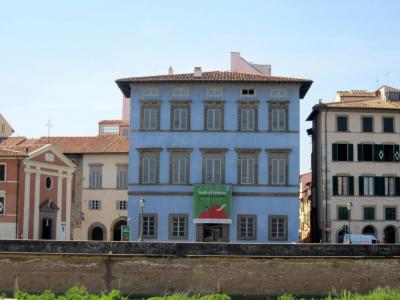Pisa Palaces Walking Tour (Self Guided), Pisa
As you continue your acquaintance with Pisa, you will notice that there is a lot more to see here than just a "leaning" landmark. Indeed, just like Italy in general, this particular Tuscan city boasts a glorious heritage of wonderful palaces, fit to transport you back in time.
The most beautiful palaces in Pisa are found on both sides of the Arno River, forming a multi-colored ribbon of facades. This palatial ribbon, albeit colorful, is in no way pompous, but elegant and pleasing to the eye.
During the reign of the Medici, the city was embellished: old palaces were “prepped up” and new ones appeared. There are currently about 40 of them well worth a visit, including:
Palazzo Arcivescovile (Archbishop's Palace) – the municipal seat of the archbishop of Pisa since 1472.
Palazzo della Carovana (The Convoy Palace) – the former headquarters of the Knight Order of Saint Stephen; whilst there is no particular architectural complexity to this building as such, its facade is of value.
Palazzo del Consiglio dei Dodici (Council of the Twelve Palace) – one of the most beautiful buildings in Pisa; another former property of the Order of the Knights of St. Stephen.
Palazzo delle Vedove (Widows Palace) – somewhat unassuming, the building was once inhabited by the Medici family's elderly female members – widows – hence the name.
Palazzo Blu (Blue Palace) – named for the blue color of the plaster, characteristic of St. Petersburg’s 18th-century palaces; painted in honor of the distinguished guests from Russia arrived in 1773.
To visit these and other historic palaces in Pisa and to learn their fascinating story, take our self-guided walking tour.
The most beautiful palaces in Pisa are found on both sides of the Arno River, forming a multi-colored ribbon of facades. This palatial ribbon, albeit colorful, is in no way pompous, but elegant and pleasing to the eye.
During the reign of the Medici, the city was embellished: old palaces were “prepped up” and new ones appeared. There are currently about 40 of them well worth a visit, including:
Palazzo Arcivescovile (Archbishop's Palace) – the municipal seat of the archbishop of Pisa since 1472.
Palazzo della Carovana (The Convoy Palace) – the former headquarters of the Knight Order of Saint Stephen; whilst there is no particular architectural complexity to this building as such, its facade is of value.
Palazzo del Consiglio dei Dodici (Council of the Twelve Palace) – one of the most beautiful buildings in Pisa; another former property of the Order of the Knights of St. Stephen.
Palazzo delle Vedove (Widows Palace) – somewhat unassuming, the building was once inhabited by the Medici family's elderly female members – widows – hence the name.
Palazzo Blu (Blue Palace) – named for the blue color of the plaster, characteristic of St. Petersburg’s 18th-century palaces; painted in honor of the distinguished guests from Russia arrived in 1773.
To visit these and other historic palaces in Pisa and to learn their fascinating story, take our self-guided walking tour.
How it works: Download the app "GPSmyCity: Walks in 1K+ Cities" from Apple App Store or Google Play Store to your mobile phone or tablet. The app turns your mobile device into a personal tour guide and its built-in GPS navigation functions guide you from one tour stop to next. The app works offline, so no data plan is needed when traveling abroad.
Pisa Palaces Walking Tour Map
Guide Name: Pisa Palaces Walking Tour
Guide Location: Italy » Pisa (See other walking tours in Pisa)
Guide Type: Self-guided Walking Tour (Sightseeing)
# of Attractions: 7
Tour Duration: 1 Hour(s)
Travel Distance: 2.1 Km or 1.3 Miles
Author: nicole
Sight(s) Featured in This Guide:
Guide Location: Italy » Pisa (See other walking tours in Pisa)
Guide Type: Self-guided Walking Tour (Sightseeing)
# of Attractions: 7
Tour Duration: 1 Hour(s)
Travel Distance: 2.1 Km or 1.3 Miles
Author: nicole
Sight(s) Featured in This Guide:
- Palazzo Arcivescovile (Archbishop's Palace)
- Palazzo della Carovana (The Convoy Palace)
- Palazzo del Consiglio dei Dodici (Council of the Twelve Palace)
- Palazzo Poschi (Poschi Palace)
- Palazzo delle Vedove (Widows Palace)
- Palazzo Toscanelli (Toscanelli Palace)
- Palazzo Blu (Blue Palace)
1) Palazzo Arcivescovile (Archbishop's Palace)
Palazzo Arcivescovile is the municipal seat of the Catholic Church. It was founded in the 4th century and became an archdiocese in 1092. At that time the first Archbishop, Dagoberta, had no palace, but he was friendly with the Countess Mathilda, daughter of Boniface the Duke of Tuscany, who lived in a small palace in a square to the east of the Piazza dei Miracoli. When the countess died in 1115 she left all her property to the Vatican.
The palace was used until 1207 by the foreign governors of Florence, but then it fell into ruin and wasn’t rebuilt until 1472, when it was named the Palazzo Arcivescovile. It has been the official residence of the archbishop of Pisa since then and houses the Archiepiscopal Archives. In 1503 the building was nearly destroyed by fire and was rebuilt by Giovanni Antonio Doscio. The magnificent interior courtyard, ground floor rooms and the main staircase were constructed by Bernardino in the 17th century.
The courtyard is surrounded by elegant archways and slender columns. There are several busts of various archbishops and an imposing statue of Moses, sculpted by Vacca in the 18th century. On the first floor is a chapel full of wonderful Baroque frescoes painted by the Melani brothers.
The palace was used until 1207 by the foreign governors of Florence, but then it fell into ruin and wasn’t rebuilt until 1472, when it was named the Palazzo Arcivescovile. It has been the official residence of the archbishop of Pisa since then and houses the Archiepiscopal Archives. In 1503 the building was nearly destroyed by fire and was rebuilt by Giovanni Antonio Doscio. The magnificent interior courtyard, ground floor rooms and the main staircase were constructed by Bernardino in the 17th century.
The courtyard is surrounded by elegant archways and slender columns. There are several busts of various archbishops and an imposing statue of Moses, sculpted by Vacca in the 18th century. On the first floor is a chapel full of wonderful Baroque frescoes painted by the Melani brothers.
2) Palazzo della Carovana (The Convoy Palace)
The Palazzo della Carovana stands on Knight’s Square and is the home of the Scuola Normale Superiore di Pisa. Built on the site of the former Palazzo degli Anziana in 1564 by Giorgio Vasari, it was commissioned by the Order of the Knights of Saint Stephen. Its name “la Carovana” or “the Convoy” refers to the three year training period undertaken by members of the Order. The Knights of Saint Stephen were an order founded by Cosimo de Medici in 1561 to fight Ottoman pirates who roamed the Mediterranean. The order was abolished in 1859.
The palace’s façade is ornately decorated with sgraffiti that represent the signs of the zodiac and allegorical figures from mythology. The originals were sculpted by del Verrocchio and Forzori from designs by Vasari. They were renovated and renewed in the early 20th century. The sculptures include the Medici coat of arms and those of the Order. The statues representing Justice and Religion were executed by Lorenzi in 1563. On the upper gallery of the palace you will see various busts of the Grand Dukes of Tuscany. These were sculpted by Foggini, Sirigatti and Tacca and added in the early 18th century. The back of the palace was rebuilt in 1930 to house the expanding school.
The palace’s façade is ornately decorated with sgraffiti that represent the signs of the zodiac and allegorical figures from mythology. The originals were sculpted by del Verrocchio and Forzori from designs by Vasari. They were renovated and renewed in the early 20th century. The sculptures include the Medici coat of arms and those of the Order. The statues representing Justice and Religion were executed by Lorenzi in 1563. On the upper gallery of the palace you will see various busts of the Grand Dukes of Tuscany. These were sculpted by Foggini, Sirigatti and Tacca and added in the early 18th century. The back of the palace was rebuilt in 1930 to house the expanding school.
3) Palazzo del Consiglio dei Dodici (Council of the Twelve Palace)
Some of the most beautiful buildings in Pisa are to be found on the Knight’s Square and the small Palazzo del Consiglio dei Dodici is one of them. The Palace of the Council of the Twelve – and the name sounds like something out of Camelot – once belonged to the Order of the Knights of Saint Stephen. It was where they held court and made decisions. The palace was first mentioned in the Middle Ages as the Palace Archive and Chancellery. In 1509 it was known as Priory Palace. The Order took it over in 1603 and the architect Francavilla rebuilt it in harmony with the other buildings on the square.
The Renaissance style façade is of peach colored plaster with the window edgings, portal with its twin columns, the coat of arms and corner cornice reinforcements in white marble. Inside there is a bust of the Grand Duke Ferdinand I de Medici and the remains of a 16th century fresco of the Assumption. There are also the coats of arms of the Medici family and of the Order. The walls in the Hearing Room feature nautical scenes painted by Lippi and Giusti in 1681. The carved and gilded ceiling has a painting representing the Virtues, painted by Salimbeni in 1602. The centerpiece of the ceiling in the Grand Hall is of the Triumph of Saint Stephen and was executed by Gabrielli in 1692.
The Renaissance style façade is of peach colored plaster with the window edgings, portal with its twin columns, the coat of arms and corner cornice reinforcements in white marble. Inside there is a bust of the Grand Duke Ferdinand I de Medici and the remains of a 16th century fresco of the Assumption. There are also the coats of arms of the Medici family and of the Order. The walls in the Hearing Room feature nautical scenes painted by Lippi and Giusti in 1681. The carved and gilded ceiling has a painting representing the Virtues, painted by Salimbeni in 1602. The centerpiece of the ceiling in the Grand Hall is of the Triumph of Saint Stephen and was executed by Gabrielli in 1692.
4) Palazzo Poschi (Poschi Palace)
You will find the Palazzo Poschi on the corners of via San Francesco and Borgo Stretto. It very well preserved as the renovation work carried out in 2005 restored it to its former elegance. The palace consists of two buildings: the 11th century tower on via San Francesco and the main body of the building built in 1496. It was constructed on three storeys, the ground floor being loggias, that now front shops and a restaurant. The arches of the arcade are supported by Corinthian-style columns with Roman capitals. The first and second floors are of red brick with 12 lovely mullioned windows, each with three slender marble columns. Since 1905 the building was used as offices and was left remarkably untouched by interior decorators.
It was built for the Poschi family, but by 1840 the owner was up to his neck in gambling debts. He fled the city and the palace was sold by auction. It was bought for a modest sum by Toscanelli, who renovated the exterior and the interior frescoes and his family lived on the upper floors until the end of the 19th century. An insurance company took it over in 1905 and stayed there until the late nineteen fifties. It remained empty for many years, until renovation work was carried out by Albertino Luciano, who carefully restored the ancient frescoes. The palace is now rented out as individual office space.
It was built for the Poschi family, but by 1840 the owner was up to his neck in gambling debts. He fled the city and the palace was sold by auction. It was bought for a modest sum by Toscanelli, who renovated the exterior and the interior frescoes and his family lived on the upper floors until the end of the 19th century. An insurance company took it over in 1905 and stayed there until the late nineteen fifties. It remained empty for many years, until renovation work was carried out by Albertino Luciano, who carefully restored the ancient frescoes. The palace is now rented out as individual office space.
5) Palazzo delle Vedove (Widows Palace)
The Italian nobility often lived in “palaces”, even if the buildings were no more than huge town houses looking very much like the houses on either side of it. This is the case with the Palazzo delle Vedove. Sadly the palace has suffered over the years and if you don’t know its there, you would walk past without a second glance. It was built on the corners of via Santa Maria and via Trento for the Bocci family and at the time wasn’t a palace. Construction was long as each successive member of the family who lived there added things on or had them pulled down. Building started in the 12th century and it was finally finished in the 14th.
On via Trento you can see part of a particularly fine example of four medieval mullioned windows, but renovation during the late 16th century partly covered them with rectangular plaster and blind windows above. The building was purchased by the Medici family and they changed the name to the Palace of Widows. The elderly female members of the family lived there – the widows. The archway and corridor above it in via Santa Maria joins the palace to the Torre de Cantone and from there another arch lead to the Chiesa San Nicola. These corridors were used by the ladies so that they could visit the church without having to walk through the streets.
On via Trento you can see part of a particularly fine example of four medieval mullioned windows, but renovation during the late 16th century partly covered them with rectangular plaster and blind windows above. The building was purchased by the Medici family and they changed the name to the Palace of Widows. The elderly female members of the family lived there – the widows. The archway and corridor above it in via Santa Maria joins the palace to the Torre de Cantone and from there another arch lead to the Chiesa San Nicola. These corridors were used by the ladies so that they could visit the church without having to walk through the streets.
6) Palazzo Toscanelli (Toscanelli Palace)
The Lanfranchi-Toscanelli Palace, built in the Renaissance architectural style, currently houses the Pisa State Archives, a role it has served since 1913.
Originally, this building was commissioned in the first half of the 16th century by Bartolomeo Lanfranchi. Some sources suggest that the renowned Michelangelo himself may have been the architect behind its design. However, in 1576, the palace underwent renovations according to the plans by Francesco Mosca.
In 1827, the affluent Toscanelli family, who were merchants, acquired the property and enlisted architect Alessandro Gherardesca to oversee its restoration. During the 1860s, the ceilings of certain rooms were adorned with frescoes portraying secular hagiography, including scenes featuring Lord Byron and Poetry, the Apotheosis of Galileo, and the Apotheosis of Michelangelo.
Giovan Battista Toscanelli and his wife, Angiola Cipriani, used the palace as their private residence and gradually amassed an extensive art collection. This collection included works by artists such as Cornelis Bloemaert, Agnolo Bronzino, Pietro Ciafferi, Jacques Courtois, Carlo Dolci, Francesco Fidanza, Károly Markó Junior, Cornelis van Poelenburgh, and Piero Zuccheri.
At one point, the palace featured an intriguing Mannerist marble sculpture, originally part of a fountain, depicting a fantastical female figure seated atop a frog. This sculpture had distinctive characteristics, including bare breasts, wings, fin-like feet, and a long tail. The attribution of this statue has been debated, with suggestions that it may have been created by Michelangelo himself or one of his followers, such as Silvio Cosini or Niccolo Tribolo. Today, this statue can be found in Blue Palace (Palazzo Blu).
Additionally, the Toscanelli Palace holds historical significance due to the visit of the English poet Lord Byron between 1821 and 1822. Byron later relocated to Albaro, near Genoa, and departed for Greece on July 16, 1823, where he ultimately met his untimely demise.
Originally, this building was commissioned in the first half of the 16th century by Bartolomeo Lanfranchi. Some sources suggest that the renowned Michelangelo himself may have been the architect behind its design. However, in 1576, the palace underwent renovations according to the plans by Francesco Mosca.
In 1827, the affluent Toscanelli family, who were merchants, acquired the property and enlisted architect Alessandro Gherardesca to oversee its restoration. During the 1860s, the ceilings of certain rooms were adorned with frescoes portraying secular hagiography, including scenes featuring Lord Byron and Poetry, the Apotheosis of Galileo, and the Apotheosis of Michelangelo.
Giovan Battista Toscanelli and his wife, Angiola Cipriani, used the palace as their private residence and gradually amassed an extensive art collection. This collection included works by artists such as Cornelis Bloemaert, Agnolo Bronzino, Pietro Ciafferi, Jacques Courtois, Carlo Dolci, Francesco Fidanza, Károly Markó Junior, Cornelis van Poelenburgh, and Piero Zuccheri.
At one point, the palace featured an intriguing Mannerist marble sculpture, originally part of a fountain, depicting a fantastical female figure seated atop a frog. This sculpture had distinctive characteristics, including bare breasts, wings, fin-like feet, and a long tail. The attribution of this statue has been debated, with suggestions that it may have been created by Michelangelo himself or one of his followers, such as Silvio Cosini or Niccolo Tribolo. Today, this statue can be found in Blue Palace (Palazzo Blu).
Additionally, the Toscanelli Palace holds historical significance due to the visit of the English poet Lord Byron between 1821 and 1822. Byron later relocated to Albaro, near Genoa, and departed for Greece on July 16, 1823, where he ultimately met his untimely demise.
7) Palazzo Blu (Blue Palace)
Situated on the banks of the River Arno, this site has been settled since the 11th century. Parts of Blue Palace date back to the 16th century. Many famous and influential families have owned this stately palace throughout the centuries.
It was renovated in the 19th century, and a wing was added to make the palace symmetrical. During this renovation, the facade was painted its current iconic blue color. The interior features rich embellishments typical of the 19th century. Blue Palace's first floor is decorated and furnished to represent a 19th-century aristocratic palace.
The Blue Palace houses the Museum of Art and Culture in Pisa. The collection features more than 300 works of art that span from the 14th to the 20th centuries. Artists represented include Nino Pisano, Cecco di Pietro, and Benozzo Gozzoli.
The museum also hosts archeological records from Pisa's history, including the Etruscan, Roman, and Hellenistic eras. The underlying road, which dates to the 12th or 13th centuries, is visible on the ground floor.
The museum often hosts temporary exhibitions with various fascinating themes such as space or Dante's Inferno.
It was renovated in the 19th century, and a wing was added to make the palace symmetrical. During this renovation, the facade was painted its current iconic blue color. The interior features rich embellishments typical of the 19th century. Blue Palace's first floor is decorated and furnished to represent a 19th-century aristocratic palace.
The Blue Palace houses the Museum of Art and Culture in Pisa. The collection features more than 300 works of art that span from the 14th to the 20th centuries. Artists represented include Nino Pisano, Cecco di Pietro, and Benozzo Gozzoli.
The museum also hosts archeological records from Pisa's history, including the Etruscan, Roman, and Hellenistic eras. The underlying road, which dates to the 12th or 13th centuries, is visible on the ground floor.
The museum often hosts temporary exhibitions with various fascinating themes such as space or Dante's Inferno.
Walking Tours in Pisa, Italy
Create Your Own Walk in Pisa
Creating your own self-guided walk in Pisa is easy and fun. Choose the city attractions that you want to see and a walk route map will be created just for you. You can even set your hotel as the start point of the walk.
Pisa Introduction Walking Tour
The city of Pisa, in Italy's Tuscany region, is best known worldwide for its iconic Leaning Tower, as well as for being the birthplace of Galileo Galilei, whom considered by many as the Father of Modern Science.
The origin of the name Pisa is a mystery, while the origin of the city itself – as Etruscan – was confirmed only in 1991.
Founded on the seashore (which had since moved... view more
Tour Duration: 2 Hour(s)
Travel Distance: 3.0 Km or 1.9 Miles
The origin of the name Pisa is a mystery, while the origin of the city itself – as Etruscan – was confirmed only in 1991.
Founded on the seashore (which had since moved... view more
Tour Duration: 2 Hour(s)
Travel Distance: 3.0 Km or 1.9 Miles
Galileo's Pisa Walking Tour
Among the names that hardly need introduction there is one of Galileo Galilei. The most illustrious son of Pisa, this 16th-17th century physicist, mathematician, astronomer and philosopher went down in history as the “Father of Modern Science” and is forever cherished as one of the world’s greatest minds.
As Galileo's hometown, Pisa boasts a number of places linked to his life, of... view more
Tour Duration: 1 Hour(s)
Travel Distance: 1.8 Km or 1.1 Miles
As Galileo's hometown, Pisa boasts a number of places linked to his life, of... view more
Tour Duration: 1 Hour(s)
Travel Distance: 1.8 Km or 1.1 Miles
The Most Popular Cities
/ view all
